Spicy peppers may not be everybody’s cup of tea. However, there are plenty of spice lovers out there who are willing to take on the challenge of trying the world’s hottest peppers. The interest in extremely spicy peppers has increased in the last decade or so. This is likely thanks to the development of new hot pepper varieties. It is also likely due to the emergence of internet shows based around the love of spicy sauces.
So what are the hottest peppers around? In this article, we’ll break down a few of the hottest peppers in the world. We’ll also explore how the rating system for spicy peppers works. Just keep in mind that new pepper varieties are being created quite quickly, each even spicer than the last. So, this list may not be so accurate in a couple of years or even months!
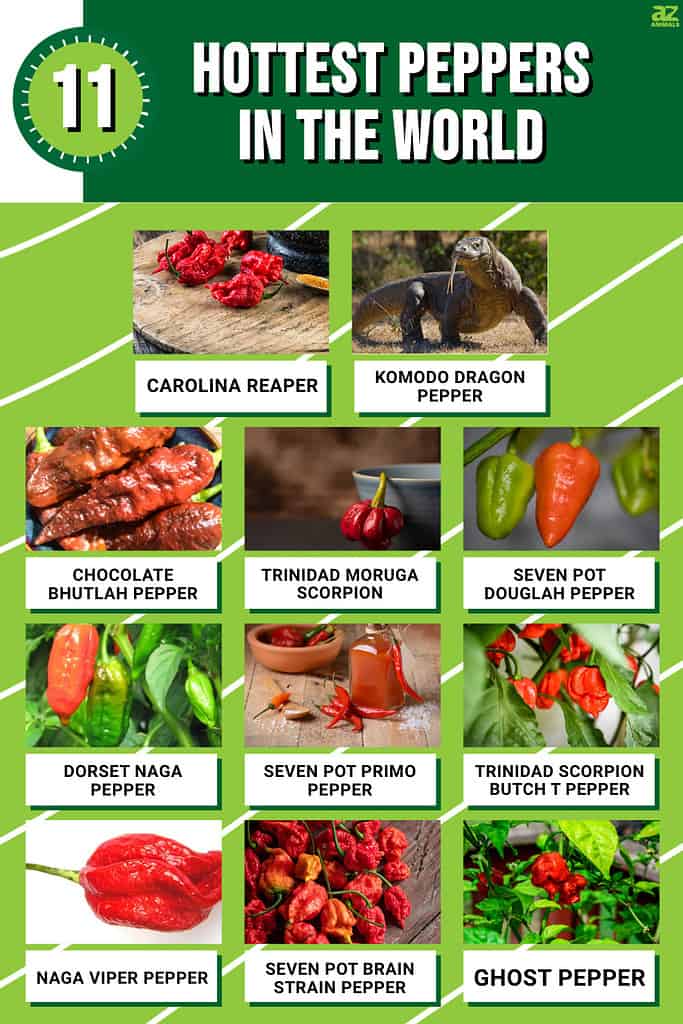
What is the Scoville Scale?
Different chili peppers’ heat levels can be measured in a specific way. The Scoville scale is the name of the most common technique. The Scoville scale uses Scoville heat units, or SHU, to categorize chili peppers according to their level of spiciness. The pungency or spiciness of chili peppers and other spicy foods can be pretty accurately gauged using the Scoville scale. It was developed in 1912 by American chemist Wilbur Scoville. This scale is still extensively used to gauge how hot peppers are.
Scoville ratings for chili peppers can range from the low hundreds to just over two million. High ratings have been observed in superhot peppers like the Carolina Reaper. So what precisely does the Scoville scale measure and how does it work?
The Scoville scale gauges the level of spiciness in chili peppers via a test that involves the dilution of a chili pepper extract with sugar water. A sample of a chili pepper’s extract is collected for tasters to eat. The sample is then diluted with sugar water over and over. This is done until the tasters are unable to perceive any heat at all with each tasting.
A pepper’s Scoville rating is determined by how many times it can been diluted. More sugar water is needed to dilute hotter peppers’ heat, giving them a higher SHU rating. Peppers that are not too spicy only need to be diluted a few times, hence a lower score.
To put it simply, the test establishes how much capsaicin is present in any chili pepper. One of the primary capsaicinoids, or chemicals that give chili peppers their hot sensation, is capsaicin. Thus, by determining the quantity of capsaicin present in hot peppers, the Scoville scale aids us in judging their level of spiciness.
Limitations of the Scoville Scale
The Scoville scale has significant drawbacks while still being a valuable tool for determining pepper spiciness. The flavor and heat perception of chili peppers, for example, might differ significantly from person to person, making it challenging to set a common norm. Additionally, the pepper’s sweetness or acidity is not measured by the Scoville scale, which only measures the pepper’s level of heat.
Alternative techniques for determining the heat of peppers have been developed by various businesses and researchers to create solutions to these limitations. These potential solutions include gas chromatography or GC, which analyzes the volatile chemicals that are responsible for a pepper’s scent and flavor; and high-performance liquid chromatography or HPLC, which evaluates the quantity of capsaicin in a pepper directly.
Although there are other ways to measure pepper spice, the Scoville scale is still the most well-known and most commonly employed approach. Just as well, it has been used for foods beyond chili peppers that include other hot foods like wasabi and horseradish.
With this in mind, let’s dive into our list of the hottest peppers in the world!
1. Carolina Reaper
Scovilles: Up to 2,200,000 SHU

Carolina reaper peppers (pictured) are currently the hottest known pepper in the world.
©Adrian_am13/Shutterstock.com
The current spiciest variety of chili pepper is known as the Carolina Reaper. It is regarded as one of the hottest peppers (that we currently know of) in the entire world. It was developed by well-known South Carolina chili farmer Ed Currie and released to the market in 2013. The pepper has an unusual look, with bright red, wrinkled, and rough skin. It’s also well renowned for having a fruity, sweet flavor that’s swiftly followed by a potent, lingering heat.
The Scoville scale for the Carolina Reaper pepper varies from 1.5 million to 2.2 million units. The jalapeño pepper, in contrast, only has a Scoville rating of 2,500 to 8,000 units. The Carolina Reaper pepper should only be ingested with caution and by people who are accustomed to spicy cuisine because of its tremendous heat. It sometimes appears in marinades, spicy sauces, and other food preparations as a flavor additive.
2. Komodo Dragon
Scovilles: Up to 2,200,000 SHU
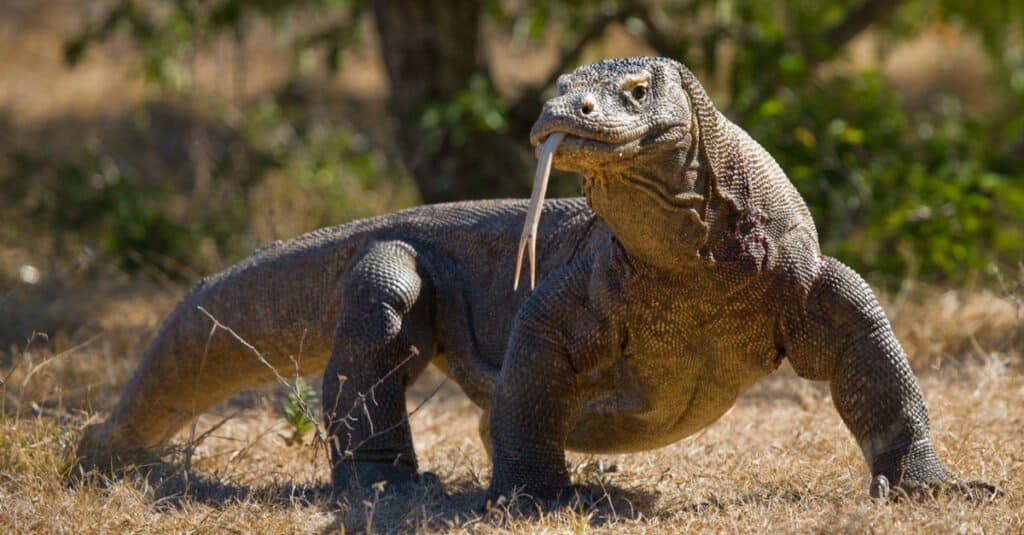
The venomous Komodo dragon (pictured) is the namesake of the Komodo Dragon pepper.
©GUDKOV ANDREY/Shutterstock.com
Another variety of chili pepper recognized for its intense heat is the Komodo Dragon pepper. Salvatore Genovese, an Italian pepper producer, created and released it to the market in 2015. The Komodo dragon, the biggest living reptile in the world, inspired the name of the pepper. It is claimed to have a heat that is as intense as the giant reptile’s venomous bite.
One of the hottest peppers in the world, the Komodo Dragon has a Scoville rating ranging from 1.4 million to 2.2 million. It is usually red or orange in hue and has wrinkled and rough skin. The pepper is characterized as having a sweet and fruity flavor with a heat that builds gradually. This pepper’s heat might take several minutes to reach its climax.
The Komodo Dragon pepper should only be handled carefully and eaten by people who are accustomed to spicy food, as with other extremely hot peppers. The Komodo Dragon can be used to impart heat to sauces, marinades, and other foods, but it should only be used in small amounts to prevent the palate from being overstimulated.
3. Chocolate Bhutlah Pepper
Scovilles: Around 2,000,000 SHU
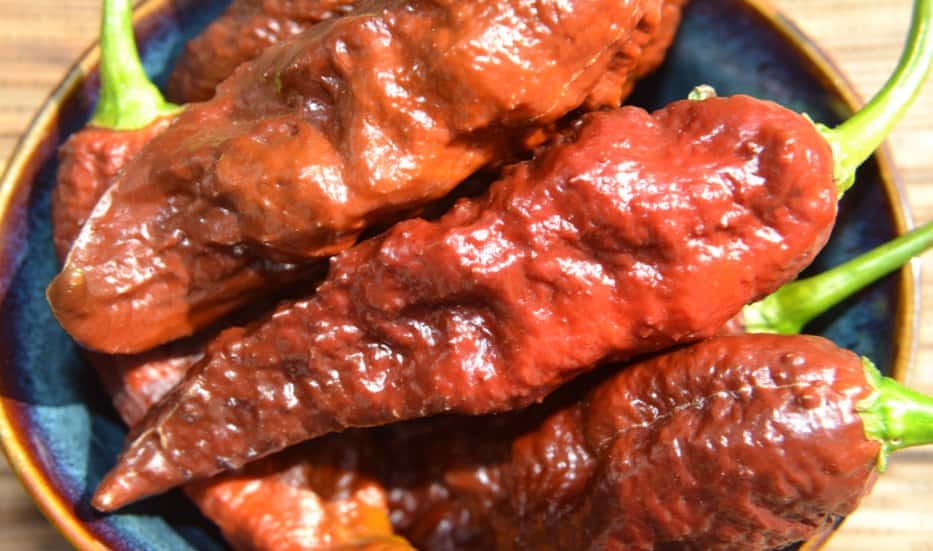
The skin of the chocolate bhutlah pepper is dark or chocolate in color and is wrinkled and rough.
©PepperParadise / CC BY-SA 3.0 – License
One of the hottest chili peppers in the world is the uncommon and exceptionally spicily hot Chocolate Bhutlah pepper. Its characteristic chocolate color comes from a hybrid between the Bhut Jolokia, better known as the ghost pepper, and the Douglah pepper. The pepper was created by Chad Soleski, a well-known producer of chilies. It was initially offered for sale in 2015.
The Chocolate Bhutlah pepper might taste somewhat spicier than the Carolina Reaper pepper, despite having a Scoville rating of only two million units. Its skin is generally dark or chocolate in color and is wrinkled and rough. The pepper has an earthy, smokey flavor with a heat that builds gradually and might take several minutes to reach its climax.
The Chocolate Bhutlah pepper should be handled carefully. It can be used to impart heat to a wide range of foods, particularly meats, but it should only be used in small amounts.
4. Trinidad Moruga Scorpion
Scovilles: Up to 2,000,000 SHU
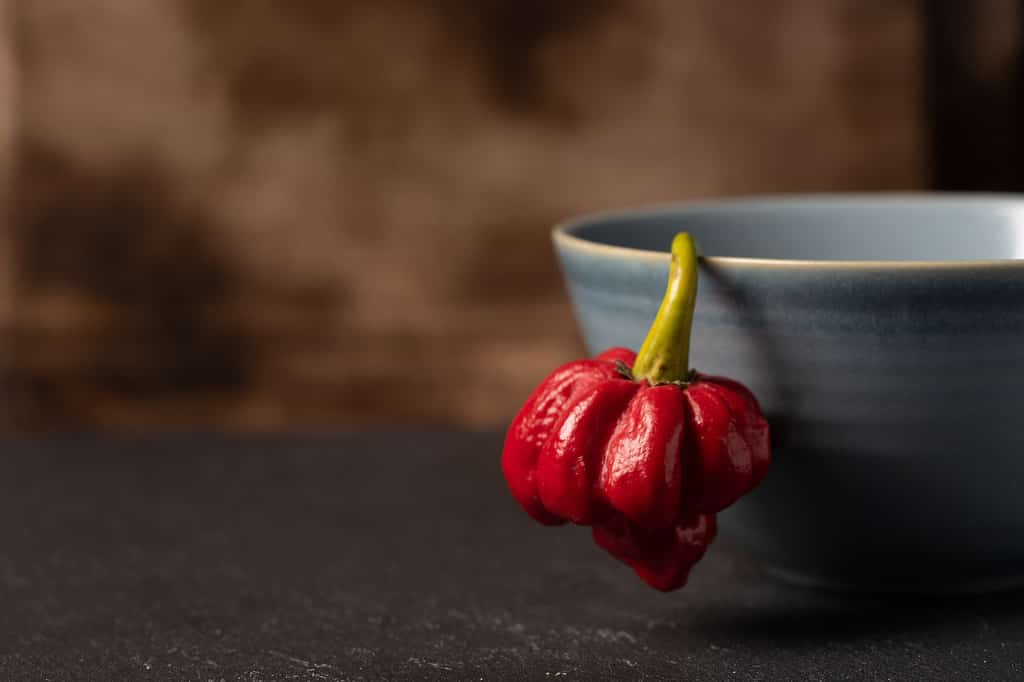
The Trinidad Scorpion Moruga (pictured) is from Moruga, Trinidad and Tobago.
©iStock.com/Marco Garcia
The Trinidad Moruga Scorpion is a type of chili pepper notable for its intense heat. It was initially found in the Moruga area of Trinidad and Tobago in the early 2000s. The skin of the pepper is usually red or orange in color and is wrinkled, as many super-hot peppers are.
The Trinidad Moruga Scorpion is one of the hottest peppers in the world with a Scoville rating of two million units. It has a slow-building burn that might take several minutes to reach its true heat, and that heat is powerful and long-lasting. The pepper’s sweet and fruity taste makes it popular in hot sauces and other recipes despite its intense heat.
The Carolina Reaper and other variations have subsequently eclipsed the Trinidad Moruga Scorpion as the hottest pepper in the world, according to Guinness World Records. However, it continues to be a well-liked option among fans of spicy cuisine.
5. Seven Pot Douglah Pepper
Scovilles: 1,853,986 SHU
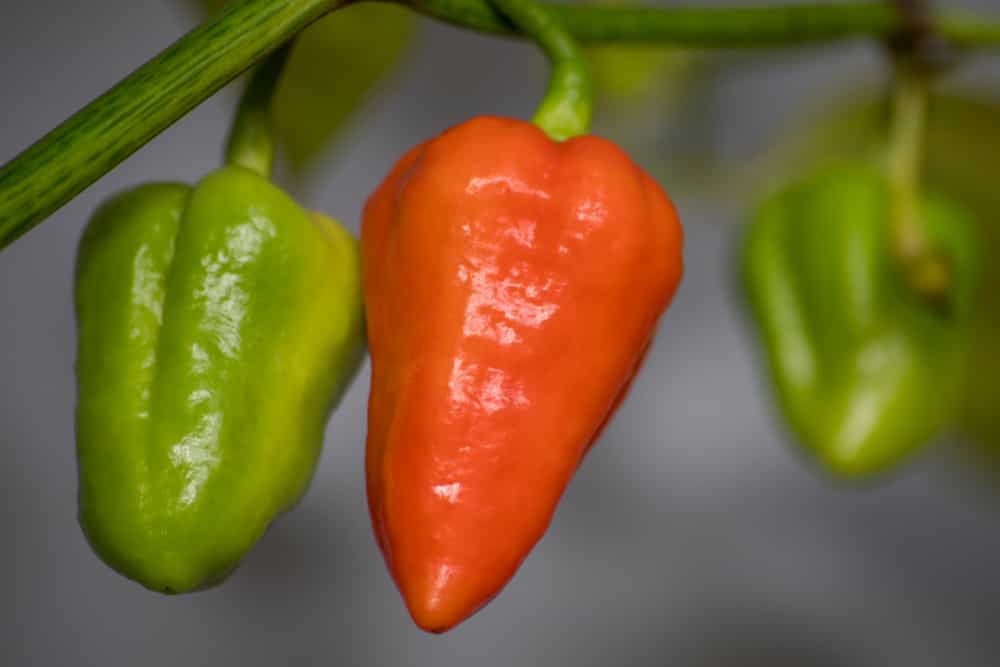
The Seven Pot Douglah pepper gets its name from the notion it can heat up seven separate stew pots as a result of its high capsaicin concentration.
©marcinm111/Shutterstock.com
This delicious and unique chili pepper is notable for its intense heat. The Seven Pot Douglah pepper was initially found in Trinidad and Tobago in the early 2000s, where it is indigenous. The skin of the pepper is often dark or chocolate in color.
One of the hottest peppers in the world, the Seven Pot Douglah has a Scoville rating of nearly 1.8 million units. It has a slow-building burn that might take several minutes to get to its hottest level with powerful and long-lasting heat. The pepper is famously used in a broad range of cuisines, especially in the Caribbean, despite its intense heat. This is because of its sweet and nutty flavor that is even more enjoyable than its hot bite.
The tongue-in-cheek notion that the Seven Pot Douglah pepper can heat up seven separate stew pots as a result of its high capsaicin concentration inspired the name of the pepper. It is a preferred option for chili aficionados and those who enjoy spicy food, and it is commonly used in Caribbean cuisine.
6. Dorset Naga Pepper
Scovilles: 1,598,227 SHU

The skin of the Dorset Naga pepper is wrinkled and candy-apple red or sometimes orange-red.
©Mwp / CC BY-SA 3.0 – License
The Dorset Naga is a chili pepper loved for its crazy-hot taste and uniquely fruit-like flavor. It was initially created in the early 2000s by farmers Joy and Michael Michaud in Dorset, a county in southwest England. This newer pepper was created by selectively growing Naga Morich peppers. The skin of the pepper is wrinkled and candy-apple red or sometimes orange-red.
With a Scoville rating of precisely 1,598,227, the Dorset Naga pepper is one of the hottest peppers on earth. It is said to have a strong and enduring heat that comes up quickly and takes the eater by surprise. The pepper’s fruity and sweet taste makes it popular in extra-spicy hot sauce products despite its tremendous heat.
7. Seven Pot Primo Pepper
Scovilles: 1,473,480 SHU
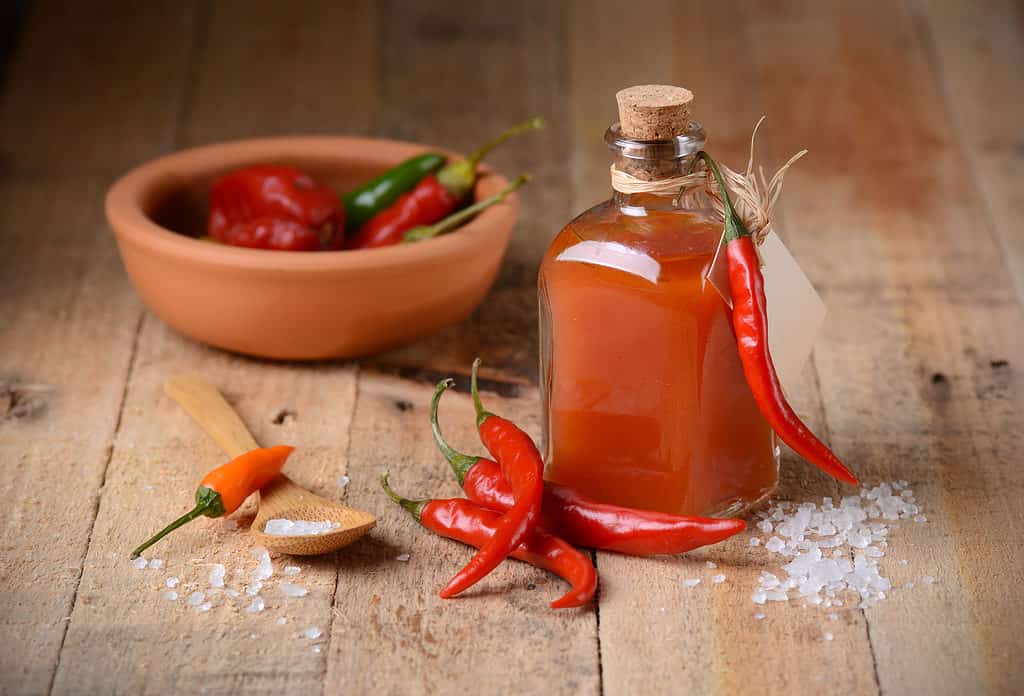
Seven pot primo peppers are used in many hot sauces and powdered pepper spices.
©al1962/Shutterstock.com
The Seven Pot Primo pepper is one heck of a hybrid! This unique spicy pepper is a hybrid between the Trinidadian Seven Pot pepper and the Naga Morich pepper from Bangladesh. It was created by a chili pepper farmer named Troy Primeaux. The skin of the pepper is usually deep red or rusty orange in color and is wrinkled and covered in bumps.
One of the hottest peppers in the world, the Seven Pot Primo has a Scoville rating of 1,473,480 SHU. It has a slow-building burn that might take several minutes to reach its maximum hotness with powerful and long-lasting heat. This pepper is commonly used in hot sauces and powdered pepper spices because it has a fruity and lemony flavor despite its high level of heat.
8. Trinidad Scorpion Butch T Pepper
Scovilles: 1,463,700 SHU

The scorpion pepper (pictured) has a number of varieties including the Trinidad Scorpion Butch T.
©iStock.com/_jure
One of the hottest peppers in the world is the Capsicum chinense variety known as the Trinidad Scorpion Butch T pepper. It is a Trinidad and Tobago native pepper. Neil Smith of The Hippy Seed Company gave it the moniker after first receiving the seeds from Butch Taylor of Zydeco Farms in Woodville, Mississippi. Taylor is responsible for propagating these pepper seeds. The pointy end of the pepper is thought to resemble the stinger of a scorpion, thus the common name “scorpion pepper” came to be for this species. The skin of the pepper is usually red or orange in color with a lot of wrinkly ridges.
According to Guinness World Records, the Trinidad Scorpion Butch T pepper held the title of the world’s most potent pepper for three years. Although it has since been surpassed by a variety of hotter rivals, this pepper is still potent and should be eaten with caution.
9. Naga Viper
Scovilles: 1,382,118 SHU

The Naga Viper Pepper is a hybrid of the Trinidad Scorpion, Bhut Jolokia, and Naga Morich peppers.
©WiKhioter / CC BY-SA 4.0 – License
Another variety of British chili pepper that has entered our list of the hottest of the hot is the Naga Viper pepper. It is a hybrid of the Trinidad Scorpion, Bhut Jolokia, and Naga Morich peppers that was created in the United Kingdom by chili pepper grower Gerald Fowler. The skin of the pepper is usually red or orange in color and has the telltale wrinkles of a spicy pepper. The pepper’s fruity and floral taste makes it a favorite in hot sauces.
10. Seven Pot Brain Strain Pepper
Scovilles: 1,350,000
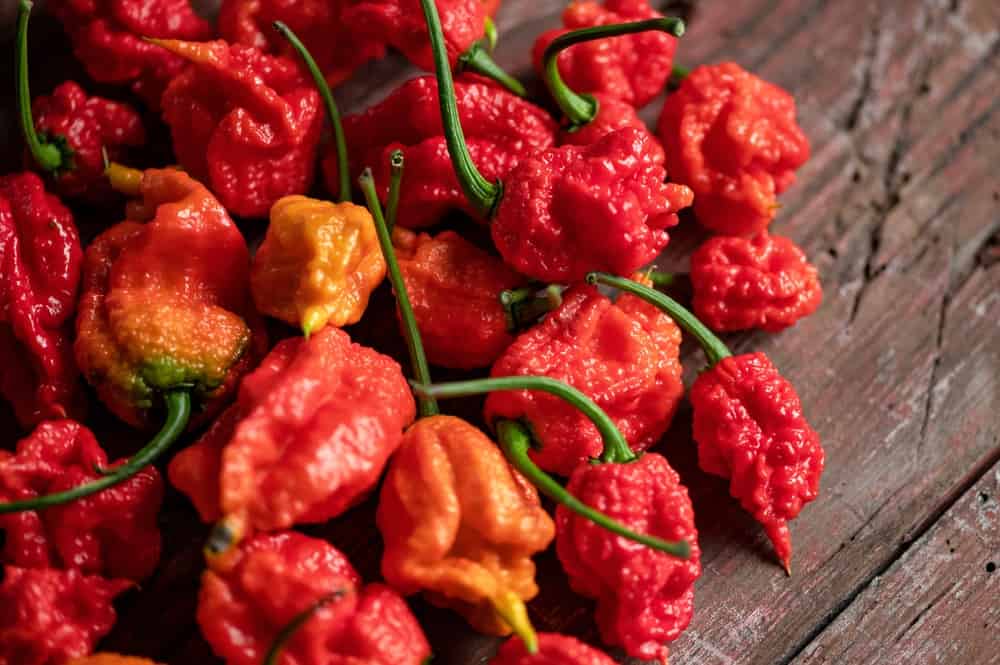
Seven pot brain strain pepper is a favorite among fans of spicy food and is frequently used in Caribbean cooking.
©artgray/Shutterstock.com
This type of chili pepper is notable for its surprising, sneaky heat. The Seven Pot Brain Strain pepper is a Trinidadian Seven Pot pepper cultivar. It is either orange or red in color and highly wrinkled, like the majority of other hot peppers. The pepper is a favorite among fans of spicy food and is frequently used in Caribbean cooking.
11. Ghost Pepper
Scovilles: Up to 1,041,427 SHU
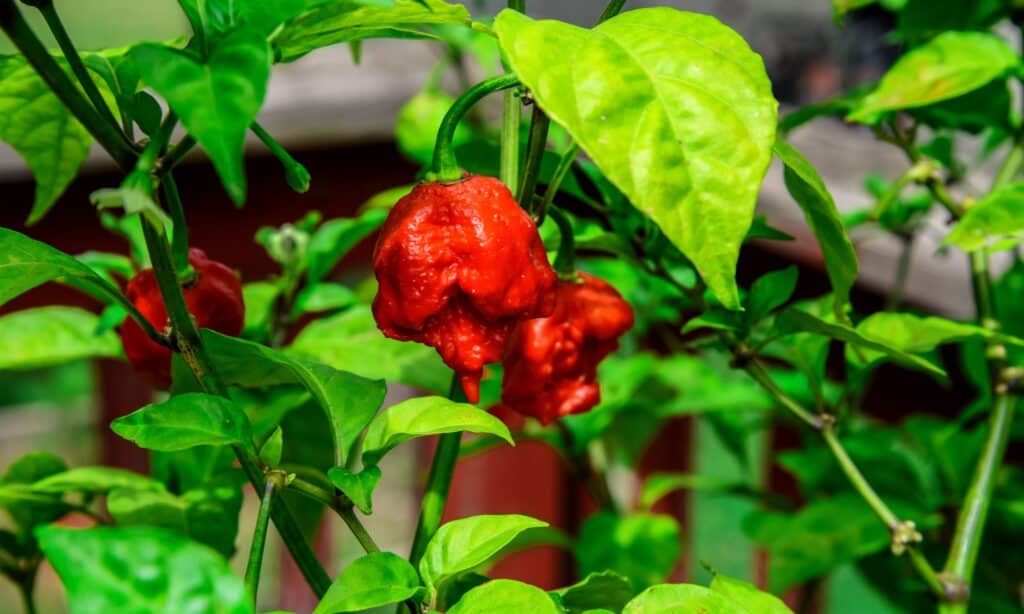
Ghost peppers (pictured) are popular in Indian cuisine.
©iStock.com/WorldExotc21
This may not be the spiciest pepper in the world, but its fame earns it a spot on this list. Ghost peppers, commonly referred to as Bhut Jolokia, are a particular variety of chili pepper that is indigenous to Northeast India. It is renowned for its intense heat and is among the hottest peppers in the world with a Scoville rating of over one million units. The ghost pepper is known for its intense and enduring spiciness that takes a long time to fade. The ghost pepper adds a hot spice to various Western meals and is very common in traditional Indian cooking.
This list of spicy peppers is not for the weak of heart (or stomach). Overall, it appears that eating spicy chilis in moderation has no long-term risks, despite the fact that eating it can be uncomfortable, sometimes for hours after eating. You may have observed that your tolerance for heat increases as you consume more spicy peppers in one sitting. However, insanely hot peppers like the Carolina Reaper can potentially cause upper gastrointestinal pain, especially for those who deal with chronic indigestion. Always use caution before taking on any spicy pepper challenge!
Summary of the 11 Hottest Peppers in the World
| Rank | Pepper | Heat Level |
|---|---|---|
| 11 | Ghost Pepper | 1,041,427 SHU |
| 10 | Seven Pot Brain Strain Pepper | 1,350,000 SHU |
| 9 | Naga Viper | 1,382,118 SHU |
| 8 | Seven Pot Primo Pepper | 1,473,480 SHU |
| 7 | Seven Pot Primo Pepper | 1,473,480 SHU |
| 6 | Dorset Naga Pepper | 1,598,227 SHU |
| 5 | Seven Pot Douglah Pepper | 1,853,986 SHU |
| 4 | Trinidad Moruga Scorpion | 2,000,000 SHU |
| 3 | Chocolate Bhutlah Pepper | 2,000,000 SHU |
| 2 | Komodo Dragon | 2,200,000 SHU |
| 1 | Carolina Reaper | 2,200,000 SHU |
The photo featured at the top of this post is © iStock.com/Wirestock
Thank you for reading! Have some feedback for us? Contact the AZ Animals editorial team.






